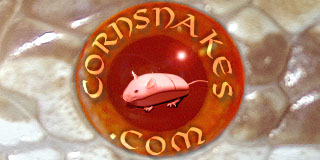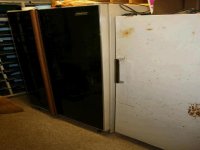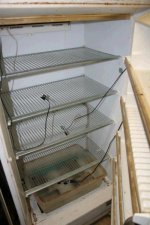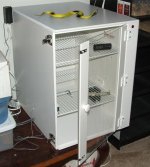El Jefe
Mark 16:18
I have already posted polls on incubation temp and substrate as well as how many times you put your pairs together. I thought I'd move on to another aspect of breeding. This time I'd like to know what type of incubator you use to achieve your desired results.
My very first clutch of eggs was sort of by accident. I was in charge of the display animals at my university and that included my corn snakes. I knew I had a pair there but I also did not do anything to manipulate cycles. No cooling, no introductions (they were cohabbed), and they stayed on a constant feeding schedule. Whoops...one day there were eggs. Well, being at the university allowed me access to one of those ultra precise laboratory incubators. Sweet! I put the eggs in and right around 55 days later I got babies.
I've come a long way since then. When I graduated, I continued breeding corns more and more and I no longer had access to my lab incubator. So...I had to build my own. My first home built incubator was a giant sterilite container...one of those big 18 inch X 36/48 inch X 18 inch high colored ones....mine was green. I took one of those giant bins and placed bricks on the bottom. I then took egg crate (that white stuff under fluorescent lights or on ceilings...it is plastic and has many squares) and put it on the bricks and then filled up the massive tub with water to the top of the bricks. After that, I placed an aquarium heater in the water, put the egg crate on top of the bricks, and then placed the clutches in shoeboxes on top of the egg crate. To maintain the temperature, I use a thermostat attached to the aquarium heater (details below). This incubation method worked very well but due to the fact there was little insulation (as compared to my current method below) the temperature was less steady if the outside temperature was unsteady.
So...I had to build my own. My first home built incubator was a giant sterilite container...one of those big 18 inch X 36/48 inch X 18 inch high colored ones....mine was green. I took one of those giant bins and placed bricks on the bottom. I then took egg crate (that white stuff under fluorescent lights or on ceilings...it is plastic and has many squares) and put it on the bricks and then filled up the massive tub with water to the top of the bricks. After that, I placed an aquarium heater in the water, put the egg crate on top of the bricks, and then placed the clutches in shoeboxes on top of the egg crate. To maintain the temperature, I use a thermostat attached to the aquarium heater (details below). This incubation method worked very well but due to the fact there was little insulation (as compared to my current method below) the temperature was less steady if the outside temperature was unsteady.
Well, more and more eggs came so I had to move beyond those incubators and on to something else. Currently, I am using two upright freezers. Actually, one is a freezer and the other is a fridge/freezer side by side model. The large side is for colubrids and the small (freezer half) side is for my pythons. The other freezer is dedicated to colubrids only. Here is how I set these up:
First I pull apart he freezer. The motor and other gear are heavy so I feel no need to keep that on the unit...plus it is fun to destroy stuff. Be careful if your freezer has not had the freon drained. It can spray out at you causing harm and I've been told it is illegal to let it go into the atmosphere. (I picked my freezers up at an appliance store where freon had been drained and they were more than happy to give them to me. Recycle!)
Be careful if your freezer has not had the freon drained. It can spray out at you causing harm and I've been told it is illegal to let it go into the atmosphere. (I picked my freezers up at an appliance store where freon had been drained and they were more than happy to give them to me. Recycle!)
Next, I put a tub of water (rubbermaid bin) on the bottom shelf (or in my fridge side I have converted the salad crisper into a tub). I then put an aquarium heater in the tub and have it on full blast. The aquarium heater is then plugged into a thermostat which is then plugged into another thermostat that is slightly higher in temperature. I do this in case the first one goes out I don't want the unit to heat up too much. However, the advantage of the water method is that the water temperature and thus air temperature only becomes so hot with an aquarium heater and thus the danger of overheating due to thermostat malfunction is less than flexwatt or a light bulb. I currently have double Johnson controls but have used Alife thermostats in the past. The other advantage of using the water and tub method is it produces a good bit of moisture. In fact, you almost have to be careful of this as the inside of the freezer will sometimes be so humid it may collect on the side doors and leak out of the unit onto the floor. But...this moisture prevents the eggs from drying out and I have yet to have a "too much" moisture problem and get a near 100% hatch rate from viable clutches. I still keep my clutches in sealed containers with just tiny holes which will allow some humidity to pass but I do not believe it is too much.
A little warning note: With either one of these systems, the one thing you do need to remember with an incubator is to place the thermostat outside of the egg containers. Several years ago a buddy of mine used a light bulb and helix thermostat to heat our albino retic eggs and put the thermostat probe in the container with the eggs. The unit would heat up and then the heat would transfer to the egg container and eventually trigger the helix controller to go off. But when the unit was off the heat on the outside of the egg container was still hotter than inside and gently diffused through and made the egg container hotter than the shutoff point. We caught it soon but a few of the outside eggs of the clutch didn't hatch and we may never know what caused it.
So...that's how I incubate...how about you?
</IMG>
My very first clutch of eggs was sort of by accident. I was in charge of the display animals at my university and that included my corn snakes. I knew I had a pair there but I also did not do anything to manipulate cycles. No cooling, no introductions (they were cohabbed), and they stayed on a constant feeding schedule. Whoops...one day there were eggs. Well, being at the university allowed me access to one of those ultra precise laboratory incubators. Sweet! I put the eggs in and right around 55 days later I got babies.
I've come a long way since then. When I graduated, I continued breeding corns more and more and I no longer had access to my lab incubator.
Well, more and more eggs came so I had to move beyond those incubators and on to something else. Currently, I am using two upright freezers. Actually, one is a freezer and the other is a fridge/freezer side by side model. The large side is for colubrids and the small (freezer half) side is for my pythons. The other freezer is dedicated to colubrids only. Here is how I set these up:
First I pull apart he freezer. The motor and other gear are heavy so I feel no need to keep that on the unit...plus it is fun to destroy stuff.
Next, I put a tub of water (rubbermaid bin) on the bottom shelf (or in my fridge side I have converted the salad crisper into a tub). I then put an aquarium heater in the tub and have it on full blast. The aquarium heater is then plugged into a thermostat which is then plugged into another thermostat that is slightly higher in temperature. I do this in case the first one goes out I don't want the unit to heat up too much. However, the advantage of the water method is that the water temperature and thus air temperature only becomes so hot with an aquarium heater and thus the danger of overheating due to thermostat malfunction is less than flexwatt or a light bulb. I currently have double Johnson controls but have used Alife thermostats in the past. The other advantage of using the water and tub method is it produces a good bit of moisture. In fact, you almost have to be careful of this as the inside of the freezer will sometimes be so humid it may collect on the side doors and leak out of the unit onto the floor. But...this moisture prevents the eggs from drying out and I have yet to have a "too much" moisture problem and get a near 100% hatch rate from viable clutches. I still keep my clutches in sealed containers with just tiny holes which will allow some humidity to pass but I do not believe it is too much.
A little warning note: With either one of these systems, the one thing you do need to remember with an incubator is to place the thermostat outside of the egg containers. Several years ago a buddy of mine used a light bulb and helix thermostat to heat our albino retic eggs and put the thermostat probe in the container with the eggs. The unit would heat up and then the heat would transfer to the egg container and eventually trigger the helix controller to go off. But when the unit was off the heat on the outside of the egg container was still hotter than inside and gently diffused through and made the egg container hotter than the shutoff point. We caught it soon but a few of the outside eggs of the clutch didn't hatch and we may never know what caused it.
So...that's how I incubate...how about you?
</IMG>






